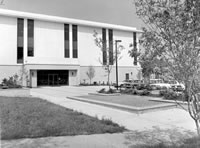This History of Public Library Service in Durham, 1897-1997 by Jessica Harland-Jacobs
Conclusion: The End of the Book?
In 1997, ninety-nine years after the Durham Public Library lent its first book, the county government agreed to provide funding for an entirely new aspect of library service: public Internet access.
Reflecting both historical trends and current debates, this development sheds light on three critical themes of public library service: modernization, the function of a library, and access to its holdings. Taken together these themes all relate to the broader issue of change. Since it is the province of history to trace continuity and change over time, the Durham County Library's centenary presents an opportune time to evaluate the effects of change on library service in Durham.
The history of Durham's public libraries demonstrates a commitment to keeping with the times, to offering the most modern services and following the latest ideas. Founding a tax-supported public library was a modern idea in 1897 and a truly innovative step in North Carolina at the end of the nineteenth century. Lillian Griggs offered modern library service by running the library like a business. And she was ahead of her times when she launched the bookmobile. Durham was at the forefront of library design in 1921 when it built its Carnegie library with its central circulation desk, open stacks, and a light, airy atmosphere. Many decades later, Linder envisioned a state-of-the-art facility that would provide equal access to all of Durham's diverse communities.
The commitment to offering Internet access reveals that Durham again seeks to be on the vanguard of public library service. Keeping up with innovative ideas and technology is indeed critical to the success of any institution. Durham's leaps forward were punctuated by periods of torpor and conservatism. The extremes to which the library ran over the course of its history indicate that at times when Durhamites embraced change, the results have been positive. When new ideas, practices, and facilities were rejected, the consequence was stagnation.
Another issue the commitment to providing Internet service brings to light is the library's changing role in society. When Durham founded its public library in 1897 Americans were engaging in a nationwide debate about whether the library should carefully guard its doors and preserve its valuable wares, or should serve as an institution where all people could come to think, learn, and find answers to their questions. In 1997 Americans are again engaged in a nationwide debate, this time about the relationship between traditional library services and rapidly moving technology. Should the library maintain its traditional mission as a storehouse for books and risk becoming obsolete as individuals increasingly find information through computers and the Internet or should libraries themselves emphasize information technology over books?
Thankfully, communities are not faced with an either-or
situation. Durham has a strong history of providing books to the public. There will always be people who feel that nothing replaces a good book as well as those who, for one reason or another, reject technology. The library should maintain its commitment to meeting their needs and promoting the experience of reading in books. But at the same time, keeping in line with its history of embracing change and modern ideas, the library should remain abreast of technological innovations. Certainly CD ROMs and the World Wide Web do not signify the end of the book, but rather the expansion of its definition and capabilities. The challenge is striking the right balance between traditional and innovative services.
Third, offering Internet service through the public library brings up the critical issue of access. Durham's librarians have dealt with this question since the beginning, when library services were initially available only to white citizens who lived within the city center. Griggs, Wooten, Crawford, and Wheeler established a strong tradition of providing services to those who were handicapped by the distance between themselves and the library. The answer to the issue of access in the early decades of the century was the bookmobile, and gradually the clientele of the public
library expanded until it included all residents of Durham County.

Durham County Library, early 1980s
The Internet presents problems similar to those of early public libraries. Accessible only through a computer terminal, its clientele
is necessarily limited to those who can afford a computer (or have one at their disposal) and navigate their way around cyberspace. The public library, among other places, is an ideal location for increasing public access to the Internet and for those who cannot make it to the main library or a branch, perhaps the library will adopt the same approach it did seventy years ago and launch a webmobile.
Finally, in assessing the past, present, and future of Durham's public library movement, one cannot help but return to the issue of race. De facto, if not de jure, segregation persists in Durham's neighborhoods, schools, and churches. This is not to deny that significant progress has been made on this front but much more remains to be done. The library is one of just a few institutions that can serve as a meeting place for Durham's multifarious communities. It provides a forum for discussion and a place for the appreciation of difference. The library, in short, is ideally a place for all people to come, have equal access to services, and exchange ideas and opinions. Certainly this should be the goal of a community as it contemplates and celebrates one hundred years of public library services.
